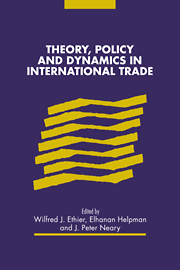Book contents
- Frontmatter
- Contents
- List of conference participants
- I Introduction
- II History, geography and the theory of trade
- 3 The hub effect: or, threeness in interregional trade
- 4 International trade and factor mobility with an endogenous land frontier: some general equilibrium implications of Christopher Columbus
- 5 Directions of lumpy country trade
- III The structure of simple trade models
- IV Policy towards international trade
- V Trade, growth and dynamics
- Index
3 - The hub effect: or, threeness in interregional trade
Published online by Cambridge University Press: 16 March 2010
- Frontmatter
- Contents
- List of conference participants
- I Introduction
- II History, geography and the theory of trade
- 3 The hub effect: or, threeness in interregional trade
- 4 International trade and factor mobility with an endogenous land frontier: some general equilibrium implications of Christopher Columbus
- 5 Directions of lumpy country trade
- III The structure of simple trade models
- IV Policy towards international trade
- V Trade, growth and dynamics
- Index
Summary
In his delightful Graham lecture Ron Jones mounted a spirited defense of “two-ness” in trade models. So it is with some trepidation that I offer in this paper a model where one cannot even discuss the subject without counting up to three! In justification I can only claim that what Ron meant was not that two is a magic number, but that it is useful to study small models – and in that sense this paper is a (small!) addition to the lovely house that Jones built.
The subject of the paper is that of the role of transportation “hubs” in the pattern of interregional and perhaps international trade. By this I do not mean anything very profound; I simply mean a situation in which the costs of transportation between locations differ in such a way that one location can reasonably be described as a transport “hub.” One cannot have a hub in this sense with only two locations, but one can with three, as illustrated in Figure 3.1. In that figure, we suppose that consumption and production take place at the three locations 1, 2, 3. There are some costs of transportation between these locations. Transport costs are, however, lower between 1 and either 2 or 3 than between 2 and 3. Thus 1 is the “hub” of this network. What I want to argue is that (i) transportation hubs are especially desirable places to locate the production of goods and services subject to increasing returns, and (ii) the interaction between increasing returns in production and in transportation leads to the endogenous formation of such transportation hubs.
- Type
- Chapter
- Information
- Theory, Policy and Dynamics in International Trade , pp. 29 - 37Publisher: Cambridge University PressPrint publication year: 1993
- 34
- Cited by



